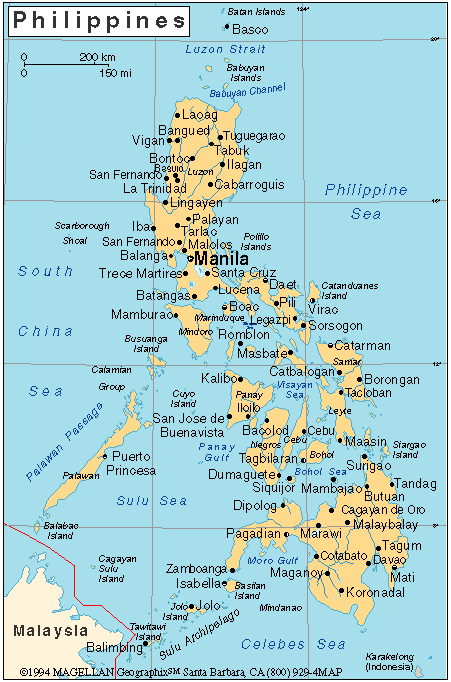 Back to:
Tibbetts House
Back to:
Tibbetts House
Back to:
Tibbetts House
THE PHILIPPINES
Geography: The Philippine archipelago is composed of 7107 islands comprising a total land area of about 300,000 square kilometers and a total coastline of around 34,539 kilometers. In size, it is bigger than Great Britain and twice the size of Greece. The entire archipelago is divided into three major groups of islands which are Luzon, Visayas and Mindanao. Five prominent bodies of water surround the archipelago, namely: the Pacific Ocean, the Philippine Sea, the South China Sea, the Sulu Sea, and Celebes Sea.
Climate: The Philippine's tropical climate has a relatively high humidity, mild temperature, abundant rainfall and gentle winds with three pronounced seasons: wet or rainy season from June to October; cool and dry from November to February; hot and dry from March to May.
Language: There are 11 cultural and racial groups, each with it's own language. The major linguistic groups are Tagalog, Ilocano, Cebuano, Hiligaynon, Bicol, Waray, Pampango and Pangasinan. English is widely used in government, business, and as a medium of instruction in schools. Spanish, Arabic and Chinese are spoken by only a minority of the population.
History: Long before the Europeans came to Asia, the Filipinos were already civilized. They possessed a Malayan civilization which had been enriched by Indian, Chinese and Arabic influences.
On March 16, 1521, Ferdinand Magellan, a Portuguese voyager in Spain's service, made the first European contact with the Filipinos after which followed three centuries of Spanish Colonial rule. Towards the end of the 19th century, Jose Rizal, a multi-faceted genius led the reform movement. Rizal is the country's national hero and is regarded as Southeast Asia's first martyr to nationalism. On June 1898, Gen. Emilio Aguinaldo declared the independence of the Philippines from Spain at Kawit, Cavite. That independence was short-lived, however, since the American again colonized the country for almost 50 years. On July 4, 1946, independence was gained from the Americans.
The colonial experience wrought under the Spanish and American administration has left it's mark on Filipino religion, language and culture.
THE PHILIPPINES